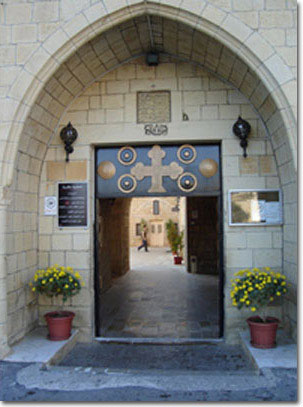|
 St.
George monastery of Homeyra lies in Wadi Al-Nassara. between Homs and
Tripoli, only few minutes away from the Knights Castle (Krak des
chevaliers). St.
George monastery of Homeyra lies in Wadi Al-Nassara. between Homs and
Tripoli, only few minutes away from the Knights Castle (Krak des
chevaliers).
According to Arabic and western sources, the history of the monastery
goes back to the 6th century during the reign of Emperor Justinian. It
was consecrated to St. George, the glorious martyr (Jirjis according to
the historian al Tabari), called by non Christians as "lord al-Khodr
Abu al-Abbas". It is probable that the name of the monastery "Homeyra" is probably
related to an ancient village which bore this name in regard to the god
of rain among the primitive peoples. Some scholars say that the word
"Homeyra" derives from the Greek "Homyros" which means the "torrent"
and we know that, during winter, the region is open to heavy rains and
to great torrents. There other assumptions for this name, but none is
confirmed by any scholars or historians.. 
St. George monastery was built near the public Roman Highway which
leads from the maritime coast to the interior land like Homs, Palmyra
and through the desert. The monastery was originally a cave surrounded by some cells of simple
monks. It has a southern Byzantine façade with the main entrance. The
gate and the fresh olds are sculptured from black stone. Near the gate, there is a stone window used by monks to distribute
bread and food to the needy and to those passing-by. On the other hand,
the monks used the same window to teach the gathered people the basics
of ethics and religion. The second floor was built in the 12th century during the Crusades. Its black-stoned door is as large as that
of the first floor; it opens to the west. A cross is sculptured on it
and is called the door of the horse because, in spite of its
narrowness, a horse uses to enter through it. On this floor, there is a church called the "old" in regard to the new
one, the third floor, this old church has a semi-circular arch and a
wooden Iconostasis, accurately and strictly carved, has
a group of Icons painted by an 18th century Arabic school of painting
which inherited the Byzantine art, giving it a local tint. This art
attracted a group of Icon admires who stole the Icon of St. George and
sold it in London. Fortunately the international Police (Scotland Yard) found the Icon and
a few years ago, it was brought back to the monastery. The modern third floor has a splendid church which goes back to the 19th century. The church has a magnificent wooden Iconostasis, considered
one of the most important in Syria and Lebanon. It took 34 years to be
carved and its Icons are painted by the Jerusalem school in the 19th century. Among the treasures of the monastery, we find ecclesiastical vessels
like cups, trays, crosses and others which are unique in the Christian
world. We find as well, manuscripts, documents, decrees and privileges
from the Arabic era and gifts from the Armenian, Georgian Russian
kings. The monastery is registered among the most important monuments in
Syria. With the knights Castle, it is considered as a famous tourist
center. Above all, peoples of different races and religions visit the
monastery, bring their vows and offerings and venerate the miracle of
its patron Saint. There are about 55 rooms in the monastery to welcome the crowded
visitors, namely on two occasions a year: the first is of the 6th of May, The feast of St. George. And the second on the 14th of September, the elevation of the Holy Cross.
 
|


